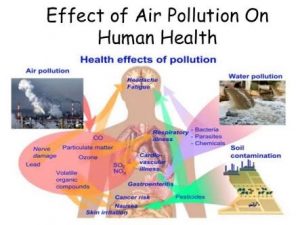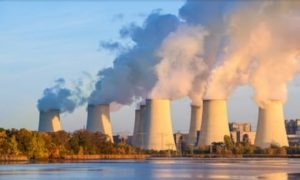Month: March 2022
Air Pollution Affects The Human Health
Air Pollution Affects the Human Health : Air pollution is a major concern in the new civilized world, which has a serious toxicological impact on human health and the environment. It has a number of different emission sources, but motor vehicles and industrial processes account for the major part of air pollution. Long and short-term exposure to airborne toxicants has different toxicological impacts in humans, including respiratory. Several reports have revealed the direct association between the exposure to poor air quality and an increasing rate of morbidity and mortality, mostly due to cardiovascular and respiratory diseases.
Air Pollution Affects the Human Health
Air pollution is considered a major environmental risk factor in the incidence and progression of some diseases, such as asthma, lung cancer, ventricular hypertrophy, Alzheimer’s and Parkinson’s diseases, psychological complications, autism, retinopathy, fetal growth, and low birth of weight. In this review article, we aimed to discuss the toxicology of major air pollutants, their sources of emissions, and their impacts on human health. We have also proposed the practical measures to reduce the air pollution in Iran.
Air Pollution Affects the Human Health
Air pollution is the black cloud belching from the industrial smokestack. It’s the smog that is settles over some cities, dimming the skyline. It’s the smelly exhaust of an old car that burns oil.
Air pollution can also be invisible and odorless. It can be cause lung damage, cancer or other serious health problems in people who may not realize the possible danger of the unseen gases or particles in the air.
The effects of the air pollution vary from person to person. A healthy adult who is exposed to these pollutants for a short time or at a low dose may not have long-term problems. For these people, even a small dose or short exposure can make symptoms worse. Longer exposure or a higher dose can be lead to serious illness. In some cases, it can lead to death.
Air Pollution Affects the Human Health
Air pollution affects people in different ways. Older people, children and those with pre-existing health conditions are more sensitive to the health impacts of the air pollution. In addition, the most deprived people in society often have poorer in health and less access to high-quality medical care, increasing their vulnerability.
Human activities have an adverse effect on the environment by polluting the water we drink, the air we breathe, and the soil in which the plants grow.
Without any doubt, the global environmental pollution is considered as international public health issue with multiple facets. Social, economic, and legislative concerns and lifestyle habits is related to this major problem. Anthropogenic air pollution is the one of the biggest public health hazards worldwide, given that it accounts for about 9 million deaths per year.
The long-term effects associated with the air pollution are chronic asthma, pulmonary insufficiency, cardiovascular diseases and cardiovascular mortality. According to the Swedish cohort study, diabetes seems to be induced after long-term air pollution exposure. Moreover, the air pollution seems to have various malign health effects in human.
The World Health Organization (WHO) reports on six major air pollutant, namely particle pollution, ground-level ozone, carbon monoxide, Sulphur oxides, nitrogen oxides. Air pollution can have the disastrous effect on all components of the environment, including groundwater, soil, and the air. Additionally, it poses the serious threat to living organisms. Acid rain, global warming, the greenhouse effect, and climate change have an important ecological impact on air pollution.
People exposed to the high concentrations of air pollutants experience disease symptoms and states of greater and lesser seriousness. These effects are grouped into short-term and long-term effects affecting health.
Susceptible populations that need to be aware of health protection measures include the elderly, children, and people with diabetes and predisposing heart or lung diseases, especially asthma.
Causes
- determining and characterizing whether air pollution has an effect on key reproductive factors and critical stages of development;
- determining the role of acute and chronic sociodemographic factors in health disparities caused by air pollution;
- Understanding how diet modifies responses to the air pollution;
- Evaluating long-term lifestyle and chronic disease effects on the air pollution-induced respiratory and cardiovascular responses.
Air pollutants and their toxicities
According to the World Health Organization (WHO), particle pollution, ground-level O3, CO, Sulphur oxides, nitrogen oxides and lead are the six major air pollutants that harm human health and also have the ecosystem.
There are many pollutants of suspended materials such as dust, fumes, smoke, mists, gaseous pollutants, hydrocarbons, volatile organic compounds (VOCs), polycyclic aromatic hydrocarbons and halogen derivatives in the air, which at high concentrations cause the vulnerability to many diseases, including different types of cancers.
Air pollution is considered a major environmental risk factor in the incidence and progression of some diseases such as asthma, lung cancer, ventricular hypertrophy, Alzheimer’s and Parkinson’s diseases, psychological complications, autism, retinopathy, fetal growth, and the low birth weight.https://www.apzem.in
Thermal Pollution
Thermal pollution, sometimes called “thermal enrichment,” is the degradation of water quality by any process that changes ambient water temperature. Thermal pollution is the rise or fall in the temperature of a natural body of water caused by the human influences. Thermal pollution, unlike chemical pollution, results in a changes in the physical properties of water.
The Main Cause of Thermal Pollution
Many humans and natural factors contribute to the problem of thermal Pollution. The single biggest causes of thermal pollution are probably cooling for industrial machinery and power plants. Water is the excellent cooling agent. This is why many industrial operations pull in relatively cool water to cool their machinery and let the relatively warm water flow back into the river, lake or sea.
Sources of Thermal Power Plant
- Nuclear Power Plant
- Coal-fired power Plant
- Industrial Effluents
- Domestic Sewage
- Hydro-electric power
- Thermal Power Plant
It can be occurring from water being pulled and released from natural water bodies. In the most cases, the water temperature is increased. However, a distinctive form of thermal pollution involves cold water being released into natural water bodies from storage reservoirs.
Causes
- Use of water as a cooling agent in industrial plants
- Soil erosion
- Runoff from paved surfaces
- Natural causes
- Deforestation
The effects of thermal pollution may start with a decrease in dissolved oxygen that affects the aquatic life, but it’s likely that the damage won’t stop there. In addition to killing fish and other animals, thermal pollution can be cause organisms to consume more food than they usually consume. As a result of the food chain also may be disrupted. The food chain may also be disrupted by species migrating to environments that can be sustain their survival.
Control Steps
- Cooling Towers – Cooling towers can regulate the water temperature very well by transferring heat from hot water to…
- Cooling Ponds – Cooling ponds or reservoirs are the most widely used technique for Substantial temperature reductions.
- Spray Ponds – In spray ponds, the water coming out from the condensers pass into the pond through water sprayer.
- Other Preventive Measures also control Thermal Pollution.
Prevention
- Heat water from the industries can treated before discharging directly to the water bodies.
- Heat water from the industries can be treated by the installation of cooling ponds and cooling towers.
- Industrial treated water can be recycled for domestic use or industrial heating.
- Through artificial lakes – In this lake Industries can be discharge their used or heated water at one end and water for cooling purposes may be withdrawn from the other end. The heat is eventually dissipated through evaporation.
Co-generation
Co-generation is also a wonderful idea to combat thermal pollution. In this process of co-generation, the useless heat from hot water can be recycled and used smartly in many tasks by industries.
Thermal pollution is a dangerous threat to our planet earth. If we do not start taking precautions for the same now, the problem will keep on expanding, degrading the quality of water and adversely affecting the aquatic plants and animals.
In conclusion, thermal pollution has been devastating effects on marine life. Keeping marine life healthy is most important for the air we breathe and the world we live in. With water covering 70% of the Earth’s surface and being one of our most important natural resources, we must do everything we can to protect it. When it comes to thermal pollution, there are few ways one individual can be really reducing their contribution. As for a power plants and big industrial sites, they can do much to reduce thermal pollution. As a contributing member of society, we should all have find ways to reduce our carbon footprint.



